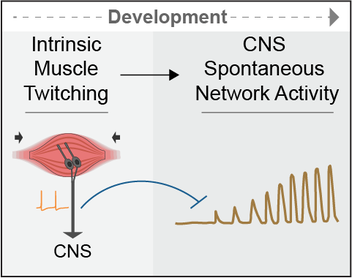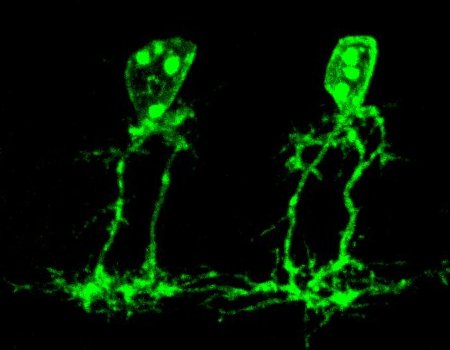How does the brain "turn on"?
All brains must transition from inactive to active during development. How the brain "turns on", and how this initial activity influences circuit formation, remain unclear. We combine imaging of neural activity in the fruit fly embryo, behavioral assays, computational analysis, and advanced genetics to gain insight from the organismal level to the molecular level. Our long-term goal is to understand how the nervous system of an animal becomes active, and how this initial activity shapes nervous system function.
Questions
How do neural circuits become active for the very first time?
|
Initial neural activity emerges spontaneously, yet at predictable locations and developmental times. How this activity initiates in a stereotyped manner is largely unknown. The general goal of this project is to reveal the developmental origin and the circuitry generating spontaneous activity with such spatiotemporal stereotypy.
|
Early neural activity of a fruit fly embryo imaged with two-photon microscopy. Particular neurons become active at predictable a time.
|
How does intrinsic muscle twitching modulate initial neural activity?
|
Intriguingly, before the brain becomes active, muscles contract on their own. We have shown that this muscle twitches, as well as downstream sensory neurons, act as a "brake" on the initiation of neural activity (a.k.a. Spontaneous Network Activity). We are studying the mechanisms for this brake to illuminate how the earliest muscle movements affect the emergence of neural activity.
|
How does activity during development shape mature neural circuitry and behavior?
|
Initial neural activity coincides with circuit wiring and the establishment of electrical properties. We are investigating how different spontaneous network activity patterns during development shape the connectivity and electrical properties of a circuit underlying a given behavior. By investigating these relationships, we aim to reveal the logic for how early neural activity influences wiring and overall function.
|
Tools
Fly genetics
|
We use fruit flies (Drosophila melanogaster) for our experiments. These animals have an accessible nervous system that shares common features with those of many animals, including humans. Fruit flies are quite smart. They have thousands of neurons and millions of synapses. Fruit flies navigate the world to find food (including in your trash can). They can also learn from past experiences. Lastly, fruit flies develop fast and offer unparalleled genetics. All this together, allows researchers to perform almost any imaginable experiment to tackle important biological questions.
Here you are seeing two fruit fly neurons with known identity, connectivity, and function. We can label their membranes (as shown here), examine their connections at the level of single-synapse, inhibit their activity with light, reduce expression of any gene of interest, and more. All these, in the context of an otherwise normal animal! |
Widefield calcium imaging
|
|
We use widefield microscopy and an highly sensitive camera to image spontaneous network activity of many fruit fly embryos in parallel. This method can capture neural activity from the moment the brain turns on for the very first time until the embryo hatches and enters larval life. To visualize neural activity, each embryo shown here expresses a genetically encoded calcium indicator.
|
Two photon imaging
|
|
We use two-photon microscopy to image neural activity at high spatiotemporal resolution. We can image the entire central nervous system once every second at single-cellular resolution. With the help of optogenetics, we can precisely manipulate neural activity in parallel. Importantly, animals remain intact in all our imaging methods.
|
Behavior
|
|
Once they hatch, fruit fly larvae crawl searching for food. We use this foraging behavior as a readout for how early neural activity influences circuit formation to sculpt mature brain function.
|
Computational
|
|
The imaging and behavior data we collect produce high dimensional data (e.g. hours-long calcium imaging sessions or dozens of individual behavioral metrics from hundreds of larvae). We use computational tools to analyze, visualize and extract meaningful information from these data.
|
|
If any of these catches your attention, reach out!
|


